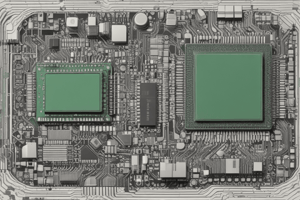Podcast
Questions and Answers
What is the primary technology used in the development of the 8085 microprocessor?
What is the primary technology used in the development of the 8085 microprocessor?
- CMOS technology
- Bipolar technology
- BiCMOS technology
- NMOS technology (correct)
What is the maximum memory addressing capability of the 8085 microprocessor?
What is the maximum memory addressing capability of the 8085 microprocessor?
- 128KB
- 256KB
- 32KB
- 64KB (correct)
Which pin is NOT a feature associated with the 8085 microprocessor architecture?
Which pin is NOT a feature associated with the 8085 microprocessor architecture?
- Video output (correct)
- Address bus
- Power supply
- Data bus
What is the operating voltage required for the 8085 microprocessor?
What is the operating voltage required for the 8085 microprocessor?
What type of operations does the 8-bit ALU of the 8085 microprocessor primarily perform?
What type of operations does the 8-bit ALU of the 8085 microprocessor primarily perform?
At what clock frequency does the 8085 microprocessor operate?
At what clock frequency does the 8085 microprocessor operate?
How many bits is the data bus in the 8085 microprocessor?
How many bits is the data bus in the 8085 microprocessor?
Which of the following is NOT a component of the 8085 microprocessor's pin diagram?
Which of the following is NOT a component of the 8085 microprocessor's pin diagram?
What is the main function of the Accumulator in the 8085 microprocessor?
What is the main function of the Accumulator in the 8085 microprocessor?
Which bus is responsible for carrying commands from the microprocessor to memory in the 8085 architecture?
Which bus is responsible for carrying commands from the microprocessor to memory in the 8085 architecture?
What does the Program Counter (PC) in the 8085 microprocessor do?
What does the Program Counter (PC) in the 8085 microprocessor do?
What is the role of the Timing and Control Unit in the 8085 microprocessor?
What is the role of the Timing and Control Unit in the 8085 microprocessor?
Which of the following correctly describes the status register in the ALU?
Which of the following correctly describes the status register in the ALU?
What does the Reset IN signal do in the 8085 microprocessor?
What does the Reset IN signal do in the 8085 microprocessor?
What is the size and purpose of the Address Bus in the 8085 architecture?
What is the size and purpose of the Address Bus in the 8085 architecture?
Which of the following flag registers indicates a carry condition in the 8085?
Which of the following flag registers indicates a carry condition in the 8085?
What is the maximum clock frequency for the 8085 microprocessor to operate effectively?
What is the maximum clock frequency for the 8085 microprocessor to operate effectively?
Which instruction is executed when the microprocessor receives the INTR signal?
Which instruction is executed when the microprocessor receives the INTR signal?
Which of the following registers is used to store temporary commands during execution in the 8085 microprocessor?
Which of the following registers is used to store temporary commands during execution in the 8085 microprocessor?
What operation does the Shifter in the ALU perform?
What operation does the Shifter in the ALU perform?
What is the role of the control bus in the 8085 microprocessor?
What is the role of the control bus in the 8085 microprocessor?
With which pair of registers can 16-bit operations be performed in the 8085 microprocessor?
With which pair of registers can 16-bit operations be performed in the 8085 microprocessor?
What is the primary function of the I/O Read operation in the 8085 microprocessor?
What is the primary function of the I/O Read operation in the 8085 microprocessor?
Which addressing mode specifies the memory address of an operand directly?
Which addressing mode specifies the memory address of an operand directly?
What interrupts are considered non-maskable in the 8085 microprocessor?
What interrupts are considered non-maskable in the 8085 microprocessor?
At which memory location does the RST 7.5 interrupt execute when activated?
At which memory location does the RST 7.5 interrupt execute when activated?
How many maskable interrupts does the 8085 microprocessor have?
How many maskable interrupts does the 8085 microprocessor have?
Which cycle occurs first in the execution of an instruction by the 8085 microprocessor?
Which cycle occurs first in the execution of an instruction by the 8085 microprocessor?
What is the primary purpose of the I/O Write operation in the 8085 microprocessor?
What is the primary purpose of the I/O Write operation in the 8085 microprocessor?
What is the clock speed at which the Intel 8085 typically operates?
What is the clock speed at which the Intel 8085 typically operates?
In which applications is the 8085 microprocessor commonly used for home appliances?
In which applications is the 8085 microprocessor commonly used for home appliances?
How does the INTR interrupt behave when the microprocessor is in a RESET state?
How does the INTR interrupt behave when the microprocessor is in a RESET state?
What type of control signals does the 8085 microprocessor use to manage data flow?
What type of control signals does the 8085 microprocessor use to manage data flow?
Which interrupt of the 8085 processor has the maximum priority?
Which interrupt of the 8085 processor has the maximum priority?
What happens during the Memory Write Cycle in the 8085?
What happens during the Memory Write Cycle in the 8085?
What is one application of the 8085 microprocessor in the military domain?
What is one application of the 8085 microprocessor in the military domain?
Which of the following does not describe a type of machine cycle in the 8085?
Which of the following does not describe a type of machine cycle in the 8085?
Flashcards are hidden until you start studying
Study Notes
8085 Microprocessor Architecture
- Developed: Intel, 1977
- Technology: NMOS
- Addressable Memory: 64KB
- Data Bus: 8-bit
- Address Bus: 16-bit
- Power Supply: +5V
- Clock Speed: 3.2 MHz
- Internal Architecture: Consists of Timing & Control Unit, Interrupt Control, Serial I/O Control, Registers, and ALU
ALU (Arithmetic Logic Unit)
- Performs arithmetic and logical operations:
- Addition: Adding two numbers
- Subtraction: Subtracting one number from another
- Increment: Increasing the value of a number by 1
- Decrement: Decreasing the value of a number y 1.
- Logical AND: Logical AND operation on two numbers
- Logical OR: Logical OR operation on two numbers
- Shift left: Shifting the bits to the left
- Shift right: Shifting the bits to the right
- Rotate left: Rotating the bits to the left
- Rotate right: Rotating the bits to the right
- Word Length: 8-bit, determined by internal data bus
Timing and Control Unit
- Responsible for generating timing signals for the execution of instructions.
- Manages the data flow and memory management between peripherals and CPU.
- Provides status, timing, and control signals to manage I/O and memory devices.
System Bus
- Used for communication between the memory and I/O devices.
- Consists of:
- Data Bus: Bidirectional, carries data between microprocessor and memory. Size determines the type of operations performed.
- Address Bus: Unidirectional, sends instructions from microprocessor to memory. Size determines the amount of memory that can be addressed.
- Control Bus: Unidirectional and Bidirectional signals, used for control and co-ordination.
Registers
- General Purpose Registers: B, C, D, E, H, and L, each 8-bit. Used as pairs (BC, DE, and HL) to perform 16-bit operations.
- Accumulator: 8-bit register within ALU, used to store data and operation results.
- Flag Register: 5 flags that track the status of operations:
- Carry Flag (CF): Indicates if an operation produced a carry.
- Parity Flag (PF): Indicates if the result has an even or odd number of set bits.
- Zero Flag (ZF): Indicates if the result of an operation is zero.
- Sign Flag (SF): Indicates if the MSB of the result is set.
- Auxiliary Carry Flag (AC): Indicates if there's a carry from bit 3 to bit 4.
- Program Status Word (PSW): Combination of the Accumulator and Flag Register (16-bit). Used for stack operations.
- Stack Pointer (SP): 16-bit register that points to the stack in memory, acting as a memory pointer.
- Program Counter (PC): 16-bit register that stores the address of the next instruction to be executed.
8085 Pin Diagram
- Address/Data Bus (A0-A15): Unidirectional, sends signals to peripheral devices. Combined for additional control signals.
- Status and Control Signals:
- ALE (Address Latch Enable): Enables the lower 8-bits of the address bus during T1.
- IO/M: Determines if the current operation is memory or I/O related.
- S0, S1: 4 combinations determine operation status:
- Opcode Fetch: Fetching instruction from memory.
- Memory Read: Reading data from memory.
- Memory Write: Writing data to memory.
- I/O Read: Reading data from an I/O device.
- I/O Write: Writing data to an I/O device.
- Interrupt Acknowledge: Acknowledging an interrupt request.
- Halt: Indicates the microprocessor is stopped.
- Clock Frequency & Power Supply
- Vcc: +5V power supply
- Vss: Ground reference
- CLK (OUT): Clock signal for other devices
- X1, X2: Used to determine the clock frequency (6 MHz for 3 MHz operation)
- Reset Signals
- RESET IN: Resets the microprocessor (PC = 0)
- RESET OUT: Used to reset other devices
- Serial I/O Ports:
- SID (Serial Input Data): Input line for serial data.
- SOD (Serial Output Data): Output line for serial data.
- Interrupts and Peripheral Signals
- INTR: Interrupt request signal
- INTA: Interrupt acknowledgment
- RST 7.5, RST 6.5, RST 5.5: Maskable interrupts with varying priorities
- TRAP: Non-maskable interrupt
- HOLD: Signal to request a hold operation.
- HLDA: Hold acknowledge
- DMA Signals:
- HOLD: Requests control of the bus for DMA transfers.
- HLDA: Acknowledges the HOLD request.
8085 Operations
- Memory Read: Reads data from memory.
- Memory Write: Writes data to memory.
- I/O Read: Reads data from an I/O device.
- I/O Write: Writes data to an I/O device.
8085 Addressing Modes
- Direct Addressing: Uses a specific memory address.
- Register Addressing: Operand is in a general-purpose register.
- Immediate Addressing: Operand is included in the instruction directly.
- Indirect Addressing: The instruction specifies the register containing the address of the operand.
- Implicit Addressing: No operands are explicitly specified.
8085 Interrupts
- External signals: Trigger interrupt handling routines.
- 5 interrupt signals:
- TRAP: Non-maskable interrupt, highest priority.
- RST 7.5, RST 6.5, RST 5.5: Maskable interrupts with decreasing priorities.
- INTR: Maskable interrupt, lowest priority.
- Interrupt Service Routine (ISR): Code executed when an interrupt occurs.
8085 Applications
- Instrumentation: Digital kiosks, security systems, printing press control panels
- Entertainment: Gaming consoles, DVD Players
- Communication: Digital telephone sets, satellite communication
- Home Appliances: Washing machines, refrigerators, ovens
- Military: Various applications
- Traffic Light Control
- Data Acquisition Systems
Machine Cycles & Bus Timings
- Machine Cycle: Time required for a single instruction execution. Four types:
- Opcode Fetch Cycle: Retrieves the instruction opcode from memory.
- Memory Read Cycle: Reads data from memory if needed.
- Memory Write Cycle: Writes data to memory if needed.
- I/O Read/Write Cycle: Performs I/O operations.
- Clock Speed: Determines the rate of data processing (typically 3 MHz).
- Bus Cycle Timing: Timing diagram that illustrates signal transitions over time during each machine cycle.
- Control Signals: Manage data flow and device operation.
- Memory & I/O Timings: Specify access times, setup & hold times for data and address signals.
Instruction Set of 8085
- Data Transfer Instructions: Move data between registers and memory locations.
- Arithmetic Instructions: Perform arithmetic operations (add, subtract, increment, decrement).
- Logical Instructions: Perform logical operations (AND, OR, XOR, NOT).
- Control Transfer Instructions: Alter the flow of program execution (jumps, calls, returns).
- Input/Output Instructions: Interact with input/output devices.
Studying That Suits You
Use AI to generate personalized quizzes and flashcards to suit your learning preferences.





